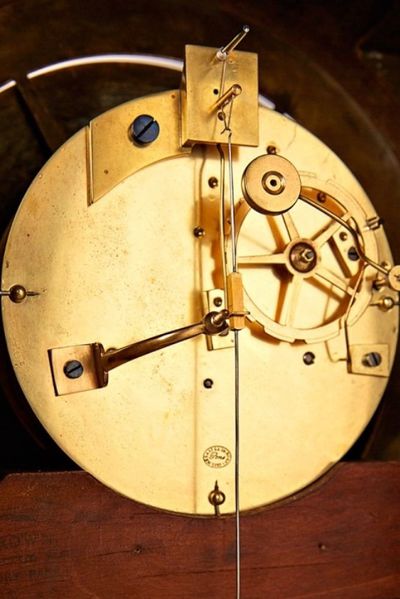Datei:Louis-Stanislas Lenoir-Ravrio, Paris, circa 1810 (7).jpg

Originaldatei (571 × 855 Pixel, Dateigröße: 110 KB, MIME-Typ: image/jpeg)
Attributed to Louis-Stanislas Lenoir-Ravrio / Honoré Pons, Saint-Nicolas d’Aliermont, Height 800 mm, circa 1810.

|
Alle Bildrechte liegen bei dem Auktionshaus Auktionen Dr. H. Crott. Diese Abbildung ist urheberrechtlich geschützt und steht nicht unter einer freien Lizenz. Für anderweitige Nutzungen außerhalb von Watch-Wiki ist die schriftliche Zustimmung des Urheberrechtsinhabers nötig. |
Louis-Stanislas Lenoir-Ravrio, Paris zugeschrieben / Honoré Pons, Saint-Nicolas d’Aliermon, Höhe 800 mm, circa 1810
Monumentale Empire Prunkpendule mit digitaler Zeitanzeige "Pendule à Circles de Tournant" und Halbstunden-Stundenselbstschlag "Der thronende Zeus, der oberste und mächtigste olympische Gott" Geh.: Bronze, matt vergoldet; rechteckiger, mit Akanthus und Blattranken reich verzierter Sockel, an den vier Ecken stilisierte, geflügelte Löwen. Quaderförmiger, glatter Aufbau mit zentralem, halbkreisförmigen Zifferblattring und zentralem Sockelrelief mit der Darstellung der jungen Neiride Thetis mit einem Löwen an einem rauchenden Altar mit flehendem Blick nach oben zu der imposanten, thronenden Figur des Zeus. In seiner rechten Hand hält er einen Stab, zu seinen Füßen befindet sich ein Adler mit ausgebreiteten Flügeln, das Attribut des Zeus. Zu seiner linken befindet sich ein Füllhorn und eine große Deckelvase mit der Aufschrift "DESTIN" ("das Schicksal"). Ziffbl.: vertikal rotierender, halbkreisförmiger, versilberter Ziffernring mit röm. Zahlen. Werk: rundes Messing-Vollplatinenwerk, feuervergoldet, 1 Hammer / 1 Glocke, 2 Federhäuser, Hakenhemmung, Schlossscheibe, Kurzpendel.
Eine nahezu identische Prunkpendule befindet sich im Schloss Fasanerie in Fulda und in der Sammlung des Mathematisch-Physikalischen Salons im Dresden. Abgebildet und beschrieben in: H. Ottomeyer und P. Pröschel, "Vergoldete Bronzen", Band I, S. 401, Abb. 5.18.28.
Die Erhabenheit und Schwere der Darstellung veranschaulicht perfekt das künstlerische Denken der Zeit. Wichtig war vor allem Repräsentation und Dekoration, Geradlinigkeit, Strenge und Feierlichkeit, welche Größe und Macht veranschaulichen sollten. Das Thema des thronenden Zeus wird deshalb von vielen Künstlern der damaligen Zeit aufgenommen. Das wohl berühmteste Beispiel ist das 1811 entstandene Gemälde "Jupiter (Zeus) und Thetis", des neoklassizistischen Malers Jean Auguste Dominique Ingres, welches sich heute im Musée Granet in Aix-en-Provence, in Frankreich befindet. Das Gemälde veranschaulicht auf imposante Weise den Kontrast zwischen der Macht der männlichen Gottheit und der zerbrechlichen, zarten Nymphe. Das Sujet in Ingres' Gemälde geht auf eine Episode der Ilias' Homers zurück, in der die Meeresnymphe Thetis Jupiter (Zeus) bittet, in das Schicksal ihres Sohnes Achilles einzugreifen, der zu dieser Zeit in den Trojanischen Krieg verwickelt war.
Louis-Stanislas Lenoir-Ravrio (1783–1846) war der Adoptivsohn des berühmten Bronziers André-Antoine Ravrio (1759-1814), der einen renommierten Kundenkreis hatte, zu dem auch Napoleon I zählte. Louis-Stanislas-Ravrio Lenoir übernimmt, nach dem Tod des Vaters, die Leitung des Ateliers in der Rue des Filles St. Thomas in Paris. 1819 erhielt er die Silbermedaille des Salons, was seinen guten Ruf und die Qualität seiner Arbeit wiederspiegelt. Ein zeitgenössischer Kritiker hob hervor, "Herr Lenoir-Ravrio genießt einen sehr guten Ruf ... Alles, was aus dieser Fabrik kommt, ist von ausgezeichnetem Geschmack."
A monumental Empire-style pendulum clock with digital display "Pendule à Circles de Tournant" and half hour strike "Zeus on the throne - the highest and most powerful of the Olympian gods" Case: matt gilded bronze; rectangular base lavishly decorated with acanthus and foliate scrolls, stylized winged lions on the four corners. Block-shaped polished structure with central semicircular dial and relief in the centre of the base: the young Nereid Thetis with a lion at a smouldering altar, looking up imploringly at the imposing Zeus on the throne. Zeus is holding a staff in his hand and at his feet is an eagle with outstretched wings - the attribute of Zeus. To his left are a cornucopia and a large, lidded vase with the inscription "DESTIN" ("destiny"). Dial: vertically rotating semi-circular, silvered chapter ring with Roman numerals. Movm.: round brass full plate movement, firegilt, 1 hammer / 1 bell, 2 barrels, anchor escapement, count wheel, short pendulum.
A nearly identical pendulum clock is kept in the Castle Fasanerie in Fulda and in the collection of the "Mathematisch-Physikalischer Salon" in Dresden. Illustrated and described in: H. Ottomeyer and P. Pröschel, "Vergoldete Bronzen", vol. I, p. 401, fig. 5.18.28.
The dignity and the gravity of the scene represent the artistic thinking of the time perfectly. Great value was laid on representation and ornamentation, straightforwardness, severity and solemnness - all of which were intended to demonstrate greatness and power. This is why so many artists of the time adopted the theme of Zeus on his throne, the most famous example being the picture "Jupiter (Zeus) and Thetis" of 1811 by neoclassical painter Jean Auguste Dominique Ingres; it is today in the Musée Granet in Aix-en-Provence in France. The painting conveys perfectly the contrast between the powerful god and the petite and delicate nymph; the subject is inspired by an episode in Homer’s Iliad, where the sea nymph Thetis begs Jupiter (Zeus) to save the life of her son Achilles during the Trojan War.
Louis-Stanislas Lenoir-Ravrio (1783-1846) was the adopted son of famous bronzer André-Antoine Ravrio (1759-1814), who counted Napoleon I amongst his wealthy clientele. After the death of his father, Louis-Stanislas-Ravrio Lenoir took over the workshop at Rue des Filles St. Thomas in Paris. In 1819 he was awarded the silver medal of the Salon, which demonstrated his excellent reputation and the quality of his work. In the words of a contemporary critic, "M. Lenoir-Ravrio enjoys a very good reputation... Everything produced by this manufactory is exquisitely tasteful."
Dateiversionen
Klicke auf einen Zeitpunkt, um diese Version zu laden.
| Version vom | Vorschaubild | Maße | Benutzer | Kommentar | |
|---|---|---|---|---|---|
| aktuell | 15:43, 17. Apr. 2015 |  | 571 × 855 (110 KB) | Andriessen (Diskussion | Beiträge) | Attributed to Louis-Stanislas Lenoir-Ravrio / Honoré Pons, Saint-Nicolas d’Aliermont, Height 800 mm, circa 1810. {{Bildrechte U|dem Auktionshaus Auktionen Dr. H. Crott}} Louis-Stanislas Lenoir-Ravrio, Paris zugeschrieben / Honoré Pons, Saint-… |
Du kannst diese Datei nicht überschreiben.
Dateiverwendung
Keine Seiten verwenden diese Datei.